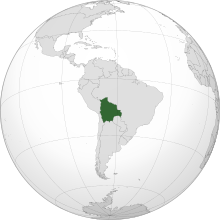Bolivia
Kaonekelo
| Plurinational State of Bolivia |
||||||
|---|---|---|---|---|---|---|
|
||||||
| Nyimbo: Himno Nacional de Bolivia (Spanish) "National Anthem of Bolivia" |
||||||
| Dual flag: Wiphala[1][2][3] |
||||||
 Makhalilo gha Bolivia (dark green) in South America (gray) |
||||||
| Msumba Waboma | La Paz (executive and legislative) Sucre (constitutional and judicial) | |||||
| Msumba usani | Santa Cruz de la Sierra 17°48′S 63°10′W / 17.800°S 63.167°W | |||||
| Chiyowoyelo chaboma | Spanish | |||||
| Co-official languages | ||||||
| Mitundu ya Ŵanthu (2009[4][better source needed]) |
|
|||||
| Vipembezo |
|
|||||
| Mwenecharu | Bolivian | |||||
| Mtundu wa Boma | Unitary presidential republic | |||||
| - | President | Luis Arce | ||||
| - | Vice President | David Choquehuanca | ||||
| - | President of the Senate | Andrónico Rodríguez | ||||
| - | President of the Chamber of Deputies | Jerges Mercado Suárez | ||||
| - | Upper house | Chamber of Senators | ||||
| - | Lower house | Chamber of Deputies | ||||
| Independence from Spain | ||||||
| - | Declared | 6 August 1825 | ||||
| - | Recognized | 21 July 1847 | ||||
| - | Current constitution | 7 February 2009 | ||||
| Ukulu wa Malo | ||||||
| - | Malo | 1,098,581 km2 (27th) 424,163 sq mi |
||||
| - | Maji (%) | 1.29 | ||||
| Chiŵelengelo cha ŵanthu | ||||||
| - | 2022 estimate | 12,054,379[5] (79th) | ||||
| - | Density | 10.4/km2 (224th) 26,9/sq mi |
||||
| GDP (PPP) | 2022 estimate | |||||
| - | Total | |||||
| - | Per capita | |||||
| GDP (nominal) | 2022 estimate | |||||
| - | Total | |||||
| - | Per capita | |||||
| Gini (2019) | medium |
|||||
| HDI (2021) | medium ·118th |
|||||
| Ndalama | Boliviano (BOB) |
|||||
| Mtundu Wanyengo | BOT (UTC−4) | |||||
| Kalembelo kasiku | dd/mm/yyyy | |||||
| Woko la galimoto | right | |||||
| Intaneti yacharu | .bo | |||||
| a. | ^ While Sucre is the constitutional capital, La Paz is the seat of government and the executive capital. See below. | |||||
Bolivia ntchalo icho chikusangika ku manjililo gha dazi chigawa cha pakati ku Amelika wa Kummwela
Longola ivyo vyabudika: <ref> tags exist for a group named "lower-alpha", but no corresponding <references group="lower-alpha"/> tag was found
- ↑ León, Ana María; Herscher, Andrew (2021). "Indigenous Modernities: The Tocapu and Other American Grids". In Hernández, Felipe; Lara, Fernando Luiz (eds.). Spatial Concepts for Decolonizing the Americas. p. 43. ISBN 9781527576537.
- ↑ Galván, Javier A. (2011). Culture and Customs of Bolivia. p. xxiii. ISBN 9780313383649.
- ↑ "Bolivia (Plurinational State of)'s Constitution of 2009, English translation" (PDF). constituteproject.org. Constitute (Oxford University Press). Archived (PDF) from the original on 2022-10-09. Retrieved 22 March 2022.
The symbols of the State are the red, yellow and green tri-color flag; the Bolivian national anthem; the coat of arms; the wiphala; the rosette; the kantuta flower and the patujú flower. (Art. 6 ii)
- ↑ "Bolivia". The World Factbook (2024 ed.). Central Intelligence Agency. Retrieved 25 March 2017. (Archived 2017 edition)
- ↑ "Bolivia". The World Factbook (2024 ed.). Central Intelligence Agency. Retrieved 24 September 2022. (Archived 2022 edition)
- ↑ 6.0 6.1 6.2 6.3 "World Economic Outlook Database, October 2022". IMF.org. International Monetary Fund. October 2022. Retrieved October 11, 2022.
- ↑ "GINI index (World Bank estimate) – Bolivia". World Bank. Archived from the original on 11 August 2018. Retrieved 17 June 2021.
- ↑ "Human Development Report 2021/2022" (PDF) (in English). United Nations Development Programme. 8 September 2022. Archived (PDF) from the original on 2022-10-09. Retrieved 8 September 2022.




